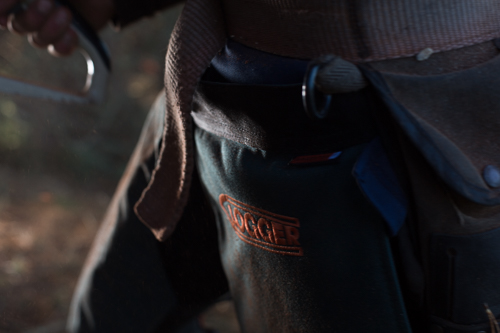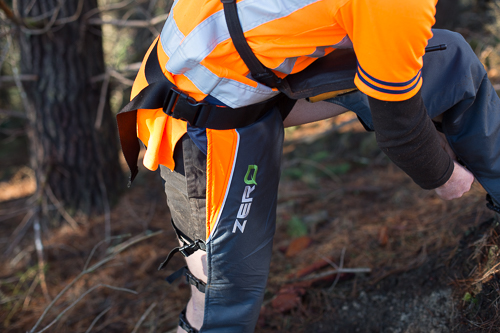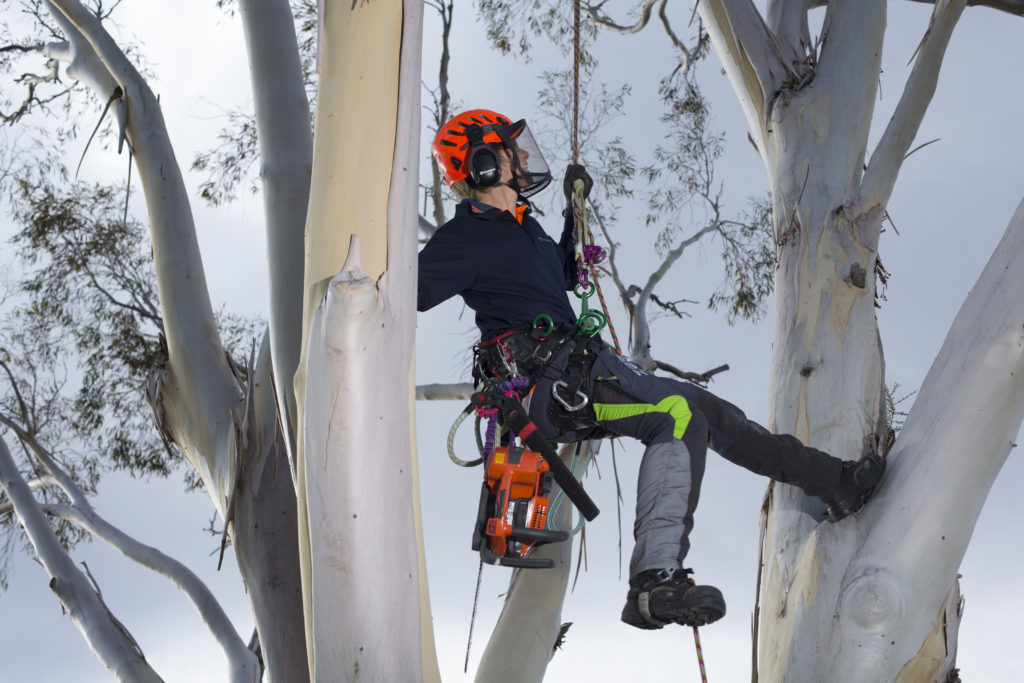The use of chainsaw chaps or pants is important.
Really important.
Continuing cases of chainsaw injuries show that there is a real need to educate many chainsaw operators on not only wearing chainsaw protection but also selecting the best chainsaw protective product for their situation, how to maintain chainsaw protective garments and other critical questions.
In this post, we review the most common questions we get asked about chainsaw protection and provide the answers that you need.

#1 Are there particular jobs you can do in chainsaw pants that you shouldn’t perform in chainsaw chaps?
Yes, there are some jobs that should not be done in chaps; namely working above the ground and operating a chipper, both because of the snagging hazard. However, this question is really part of the wider debate of pants versus chaps, for which there is no right answer. It entirely depends on the user’s needs, the environment where the operator is working, the policies of the employer and the industry regulations in place governing that work.
There are advantages and disadvantages for both:
Chainsaw Pants advantages:
- No snagging hazard during chipping or climbing operations. Garment is put on at the start of the day and any jobs can be performed during the day.
- Time saving as chainsaw pants are not put on and off.
- Garments are purchased individually so they fit correctly
- Compliance is controlled as the employee comes to work safely dressed for the job
- Garments remain functional as they are regularly washed and maintained
- Uniform, professional look for a crew when all dressed the same
- Less layering of clothing meaning it is cooler and gives better movement. (This advantage does depend on the brand of pants/chaps being compared.)
Chainsaw Pants disadvantages:
- Require workers to clean and maintain their clothing which they may not be inclined to do.
- Purchase cost is higher per person and each employee will need more than one pair
- Cannot be taken off in hot weather if not performing chainsaw jobs, new generation chainsaw pants, like the Zero’s do reduce this disadvantage
Chainsaw Chaps advantages:
- Compliance can be easily checked in a drive-by inspection
- Purchase cost is lower per person
- Not being a personal garment, they can be used by different persons (this is very good for crews who need to have chainsaw protection with them for when they need it and any of the operators can put them on)
- Can be removed in hot weather if not performing chainsaw work
- Open at the back which gives very good ventilation – this advantage is limited with calf wrap chaps
Chainsaw Chaps disadvantages:
- Cannot perform certain jobs e.g. climbing, because of snagging hazard
- Are not an individualised garment so may not be a proper fit
- Less productive due to chaps being taken on and off sometimes multiple times during a day
- No way of ensuring workers are wearing their protection when needed and are abiding by safety rules unless under constant supervision
- Tendency to not be cleaned and maintained leading to premature wearing out. Dirty garments contribute to poor overall look for company
- Hotter in warm weather and less freedom of movement due to layering of clothing. (This does depend on brand of chaps)
To sum up, the choice of whether to wear chaps or pants comes down to the employer or even the employee themselves. Questions like who pays for the gear, the lifetime cost, employee productivity, the safety culture of the company, the type and nature of the work being done and the professional image that the company wants to display, are all factors that need to be considered.
Some types of operations e.g. landscaping work, where any chainsaw work during the day is very occasional, the choice is obviously chaps, as they are universal fitting and whoever is operating the saw can wear the protection. Whereas the operator who is using a chainsaw most of the day, like a climber, groundie, faller will require protection constantly and therefore saw pants are the better choice.
#2. Are cut-resistant pants meant for climbers only?
Pants are definitely not meant for climbers only. They are a very good option for groundcrew who could be doing a variety of work, including cutting, chipping and general tree work. Wearing pants means that they always have their chainsaw protection with them, they can maximise productivity and be professionally presented.
There are often more than one option of saw pants with features targeting different work environments.
#3 How do modern chainsaw pants address the issue of heat when being worn in hot environs?
The common perception is that chaps are cooler than pants because they are open at the back.
And, older generations of chainsaw pants were typically very heavy with many layers of protection.
These were hot.
There have been however, a number of advances in pants design in recent years that are changing that perception.
- Lighter, cooler chainsaw protective fabrics
New chainsaw fabrics using highly cut-resistant fibers achieve excellent performance levels with less weight and bulk of material. They are also more breathable allowing air to move through the layers and escape.
- New technical outer fabrics
Technical fabrics are highly breathable. They actually wick moisture away. Fibers like COOLMAX and “Nilit Breeze” actively help to dissipate body heat. They also offer 4-way stretch. By using stretch fabrics for the outer material, the wearer has far more freedom of movement. Therefore he/she generates less body heat just in moving around and performing the work
- Reduced weight
Technical fabrics offer very high tear strengths in relation to weight. Lighter fabrics can then be used without sacrificing durability. The lighter fabrics, along with new pants design approaches mean that the wearer has less weight to carry around.
- Construction features
Details like vents, with or without zips to close them off, or airflow eyelets can be built into the garments to help with cooling.
Chaps are worn over the top of other garment layers, while pants are the only garment required. Less layers means less weight and bulk with better freedom of movement which translates to the wearer feeling cooler and being less fatigued.

#4 Do you think chainsaw chaps or pants are more comfortable?
Modern chainsaw pants are definitely more comfortable than chainsaw chaps.
There are no straps that rub, or that will get snagged on branches or machinery.
Modern pants will be lighter overall than chaps worn over the top of standard jeans or work pants. The old idea that hot means safer is no longer true.
Innovation in chainsaw fabric, the use of technical fabrics and new construction techniques means that lighter and cooler can actually be safer.
#5 Are chainsaw pants worth the extra cost over chainsaw chaps?
The two main reasons that we see people choose pants over chaps are the following.
- Safety
Making chainsaw pants part of the uniform means that you no longer have to worry about employees using chainsaws without protection.
This is the biggest reason for most people and companies making the switch to pants. Investing in chainsaw pants makes a big statement about the importance of safety. This is important for employers and potential clients.
Chaps have a higher risk profile. Wearing them without all the straps properly fitted and attached can result in the chap rotating causing injury.
Wearing chaps with too few straps is also unsafe. Rotation in an accident situation with these style is worse. Clogger chaps all have 5 straps.
There is also a risk of chaps being worn while chipping. Finally, there is the risk of a worker taking the chance on a cut because it is too far to go back to the truck for the chaps.
- A broader view of cost
The difference between buying a good pair of work pants and chaps is not that much less than chainsaw pants. There are also chainsaw pants designed for ground workers that are lower cost.
If you average the cost difference over a year, is the cost increase meaningful? Especially if you consider the productivity losses resulting from having to take the chaps on and off.
For example, let’s assume a worker can achieve 12 mins extra productive work per day just by not having to take chaps on and off, by being able to work better because he/she is not fatigued as much and by working quicker because he/she can move around easier.
This equates to 1 hour per week or 52 hours per year.
If we use 1 year as a typical lifetime of a garment and $70/hr as a charge-out rate for that worker, then pants could deliver savings of over $3,640 per year.
The extra cost of 2 pairs of good quality pants have well and truly paid for themselves.
- Ownership
Ownership is another factor. Pants are an individual’s responsibility with accountability.
Chaps are a shared responsibility and often are treated poorly, just being thrown into the truck.
The result is a shorter life with a higher annual cost with more replacements needed.

#6 Are chainsaw pants effective when using battery-powered chainsaws?
This question applies equally to both chaps or pants. The testing we have done shows that our Clogger “Arrestex HP” chainsaw protective fabric works effectively with electric saws.
This fabric is used in both our chaps and pants.
It utilises cut-resistant fibres that stop a chainsaw by ‘braking’ and is not reliant solely on jamming up the sprocket area. One of the concerns with electric saws is that they don’t have the same drive sprocket mechanism as gas-powered saws, therefore chainsaw protective fabric won’t work.
All modern, well-known brands such as Husqvarna, Stihl and Milwaukee, incorporate cut-off switches into their battery saws. This rapidly disengages the drive when excessive resistance is felt.
Arrestex HP, with its dual function performance, overcomes this difficulty.
Just as there is a huge range of gas-powered saws of widely varying power levels, running different chain sizes on different bar sizes, there is also a growing range of electric saws with different voltages and consequently torque levels.
There is no standard available anywhere in the world today that certifies for battery chainsaws. There is plenty of ongoing discussions but at present the current chainsaw standards are in place.
The current standard for North America; ASTM F1897-20, Canada; ASTM F3325, Australia and New Zealand; AS/NZS4453.3.1997 or that for Europe; EN381, have been in place for many years and products that comply to these standards have prevented many injuries.
It is important to note that any product that meets a standard does not purport to guarantee prevention of injury but rather to reduce the risk of injury. Even if in an accident there was a cut-through, the injury received would have been far, far worse had the user not been wearing chainsaw protection, so the garment has done what it was designed to do.
Our message is to not stop wearing pants or chaps just because you are using an electric saw.
#7 Do chainsaw pants wear out faster in normal tree work than normal work pants?
In general, fabrics utilised on chainsaw protective pants are selected for their toughness, knowing that the situations they are used in are very hard on clothing.
Fabrics used are typically constructed from high strength synthetic yarns with excellent tear-resistance and abrasion-resistance properties. Pants designs will often include high abrasion-resistant panels in wear areas.
So, chainsaw-resistant clothing is designed to be fit for purpose and to last in the environment it is used in.
On the other hand though, ordinary work pants are designed for general use and not for rigorous tree work. Fabrics used are often heavy cotton which does not have the tear strength or abrasion resistance of polyester, nylon and other manufactured yarns.
Ordinary work pants are unlikely to be made from stretch fabrics which, given the amount of movement that a tree worker needs, causes strain on the seams, the knees and other areas which have to ‘give’ to accommodate all this movement.
We think it is reasonable to conclude that chain saw pants will last longer than non-cut-resistant pants.

#8 Do I really have to discard my garment if it is cut by a chainsaw?
The chainsaw protective fabric in pants works exactly the same as chaps, so any saw cut renders the garment ineffective and it must be discarded. There is no way of repairing the inner fabric once it is cut.
When a chainsaw hits the protective pad, fibers get pulled out of the weave from the top to the bottom and from side to side in the area where the cut occurred. These fibers are dragged into the sprocket area, jamming the saw, all in a fraction of a second! Those fibers can definitely not be stuffed back inside and the outer cover stitched up.
While it may seem wasteful to throw away what is an expensive garment when it has been cut by a chainsaw, the ability of that garment to stop a second accident should it occur, is very low.
It is no longer compliant to the standard and must not be worn.
#9 I use a big saw and want the highest rated chainsaw protection available – should I be using chaps or pants?
There is a lot of confusion about chainsaw protection. Do 8 layers outperform a 6 layers? Are products that comply with the European standard Class 1 rated higher than ASTM F1897-20 certified products? Here are some answers.
Layers are important but more important is the composition and/or the thickness of the layers. The performance of the chainsaw protection depends on the material used.
A six layer fabric with a high percentage of cut resistant fibers like Arrestex HP would likely outperform an 8 or 9 layer fabric made from standard fibers.
As to European vs North American chainspeed ratings, you can not directly convert metres per second to feet per minute to compare products certified to the standards due to the different test methods used.
However, Class 1 European products tested to 20 m/s, or products tested using the same method like those in New Zealand and Australia, are likely to test significantly higher than the minimum 2750 ft/min chainsaw threshold required in the US or the 3,000 ft/min Canadian requirements.
So, if you are using a big saw and want the highest possible protection then select a garment with the highest chainspeed rating within the applicable standard. Protective fabrics made using cut-resistant fibers, although more expensive will normally provide better protection.
As to which is the better option – chaps v pants.
Remember that the attachment system is also important. There is no point in having a ‘bullet-proof’ chainsaw protective pad if it is not held in place adequately!
With Chaps, the number and placement of the number of straps is very important. There is no point having high performance chainsaw fabric if the chainsaw is able to drag the protective fabric out of the way. Our experience over many years has proved that having 5 straps makes the attachment system more effective especially with Apron chaps.
Saw Pants have continuous attachment due to the pants’ leg so are a much better choice with a high-powered saw.
#10 What is the difference between Type A and C chainsaw pants?
Type A and C refers to the designs of chainsaw leg protection (pants) defined under EN 381 standard covering protection against handheld chainsaws. Type A has front only leg protection while Type C has full 360 leg protection.
Confusingly, Canada’s Category C chainsaw pants design has front only protection while Category A has front protection with 360 calf protection.
New Zealand. Australia, and the United States only have the Type A pants equivalent defined under their respective standards though 360 calf protection is available. 360 calf wrap is available in chaps also.
See this post for a full breakdown of global chainsaw protection standards and test methods.
Summary
Choosing to wear chainsaw chaps or chainsaw trousers depends on your unique circumstances and needs, there are no right answers.
Be aware of the environment you are working in, the policies of the employer and the industry regulations in place governing that work.
The types of hazard you will encounter and the freedom of movement you expect might point you in one direction or another, but at the end it is up to you.
There is no ‘best’ in chainsaw protection, but there is a best choice for you and for your work environment.

Unfortunately you missed one extremely important aspect: all your trousers offer only Type A protection. I injured my calf a few weeks ago (experienced user) because Type A does not protect calf area by design. Your article does not mention Type A and Type C differences at all. Why don’t you offer any Type C trouser models, or at least Type A with an additional calf protection (e.g. SIP Sherpa Plus)? I would very much like to support a local manufacturer, but because of no choice and no models offering partial or full protection designs I will be buying my next trousers overseas.
We’re very sorry to hear about your injury and hope that you are recovering well. Type A and Type C are part of the European standard. Only the Type A equivalent is defined the NZ/AU standard. We do not sell our product in Europe at this stage so do not offer products made for and certified to the European standard. Our range does include a calf wrap version of the Zero and Ascend climbing pants certified to the NZ/AU standard though. We’ll add an extra section covering this whole area to the post. Thanks for your feedback.